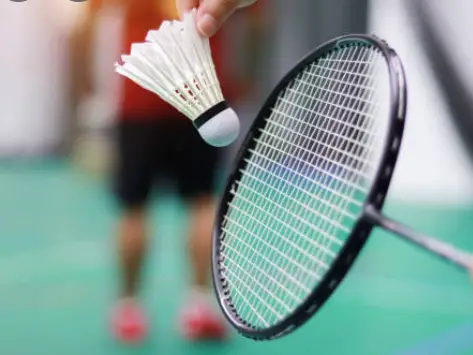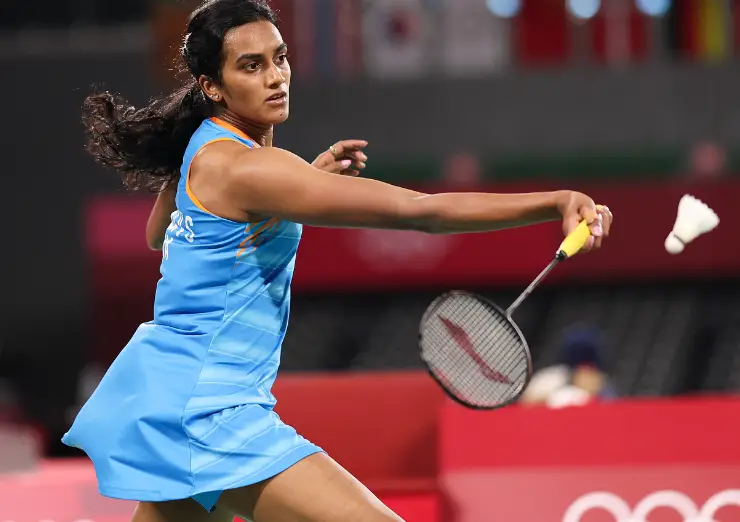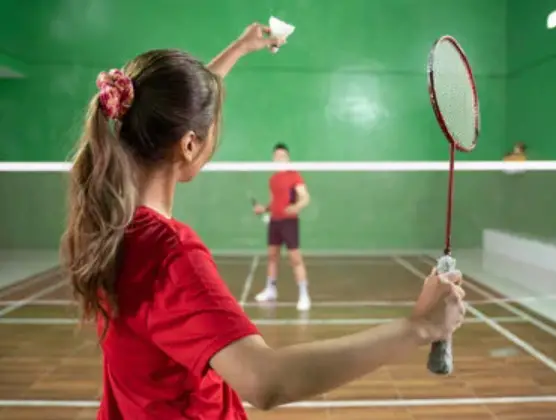There are many different tactics that make up the badminton game style and strategy, but don’t worry—they are not as hard to learn as you may imagine. You must be able to control the grip of the racket in the proper manner, which is one of the fundamental methods that is absolutely necessary. All strokes in the game may be developed and improved with the right racket grip. Since nearly every badminton technique depends on your wrist mobility and flexibility, gripping the racket properly is crucial. Some of your movements will be limited, and there’s a potential you’ll pick up the improper tactics by holding the racket incorrectly.
In order to learn badminton properly and play to your potential, it is crucial to grip the racket correctly. Having more confidence will help you as you advance in the game.
What Is Forehand Grip In Badminton?
The forehand grip in badminton is a grip that is used when hitting a shot with the front of your hand, as opposed to the backhand grip which is used when hitting a shot with the back of your hand. The forehand grip is typically used for shots that are hit in front of the body, such as forehand clears, smashes, and drives. To execute a forehand grip, the racket handle is held with the index finger and thumb on the bottom of the handle and the other three fingers wrapped around the top of the handle. The thumb should be positioned on the back of the handle and the index finger should be on the front. This grip allows for maximum power and control when hitting shots with the front of the hand.
How to do it:
To do a forehand grip in badminton, follow these steps:
- Hold the racket with your dominant hand.
- Place your index finger on the bottom of the racket handle.
- Wrap your remaining fingers around the handle, making sure your thumb is positioned on top.
- Tighten your grip and make sure your hand is comfortable and secure.
- Practice your forehand shots with this grip until you feel comfortable and confident.
What Is The Backhand Grip?
The backhand grip in badminton is a grip used for hitting shots with the backhand side of the racket. It is typically used for defensive shots, such as returns of backhand smashes or clears. To execute a backhand grip, the player holds the racket with their dominant hand on the bottom of the handle and their non-dominant hand on the top of the handle. The fingers of the dominant hand should be wrapped around the handle, while the non-dominant hand should be positioned in a claw-like shape with the fingers pointing towards the racket head. The backhand grip allows for more control and accuracy when hitting shots from the backhand side of the court.
How to do it:
- Start by holding the racquet in your dominant hand with your palm facing upwards.
- Place your index finger on the top of the racquet handle and wrap your other fingers around the handle.
- Your thumb should be on the side of the handle, close to the index finger.
- Adjust your grip so that your index finger is pointing towards the side of the racquet head, rather than towards the strings. This will give you more control over the racquet when hitting shots.
- Practice your grip by lightly hitting some practice shots, and adjusting your grip as needed until you feel comfortable and in control.
- Remember to keep your grip relaxed and flexible, as a tight grip can lead to tense muscles and poor shots.
What Is The Overhead Grip?
The overhead grip in badminton is a grip used when hitting a shuttlecock or birdie over your head. It involves holding the racquet with your thumb on the top of the handle, fingers wrapped around the handle, and your index finger pointing towards the front of the racquet. This grip allows for greater power and control when hitting a shot over your head, such as a smash or an overhead clear. It is important to use the proper grip when hitting these shots to ensure accuracy and power.
How to do it:
- Stand facing your opponent, holding your badminton racket in your dominant hand with the grip end pointing towards your body.
- Lift your arm above your head, keeping your elbow bent slightly.
- Grasp the handle of the racket with your thumb and index finger, positioning them on the top of the handle.
- Extend your arm fully, holding the racket above your head with a firm grip. This is the overhead grip.
- Use this grip when hitting overhead shots, such as smashes or clears. Make sure to keep your arm straight and follow through with the shot to generate maximum power.
What Is The Bevel Grip?
Starting with a backhand grip, turn your racket head so that your strings are now facing diagonally and place your thumb on the ridge or bevel to practice the bevel grip. If you are right-handed and are holding the racket in your backhand grip, you would rotate it counterclockwise; if you are left-handed, you would rotate it clockwise.
Uses for the bevel grip include:
- rear-court backhand strokes (clears, drops and smashes)
- a few backhanded and forehand net shots (depending on your positioning)
- If you’re really stretched out, play some singles defense.
How to do it:
- Hold the racket handle with your dominant hand, with your fingers wrapped around the handle and your thumb resting on top.
- Rotate the racket handle slightly so that it is tilted slightly towards you, with the top of the handle closer to your body than the bottom.
- Adjust your grip so that your index and middle fingers are slightly bent and your ring and pinky fingers are straight. This should give you a good balance of power and control.
- Practice your grip by hitting a few shots with the bevel grip, paying attention to how the racket feels in your hand and how well you can control the shuttlecock.
- Continue to adjust and fine-tune your grip until you feel comfortable and confident with the bevel grip. Overall, the key to a good bevel grip is finding the right balance between power and control for your individual style of play.
What Is The Panhandle Grip?
The panhandle grip is a grip used in badminton where the thumb and index finger are positioned on the top of the racket handle, similar to how one might hold a pan or frying pan. This grip is often used for forehand strokes and serves, as it allows for greater control and precision. Some players may also use this grip for overhead clear shots or smashes, although it may not be as effective for generating power as a full-hand grip.
Since it’s simple to hit overhead shots with this grip, beginners really find it to be the most natural. However, contrary to what many players believe, this grip is actually best utilized for:
- Late backhand rear-court shots
- Retrieving a net cord on the backhand side
- Some net kills or drives depending on your position and preference
How to do it:
- Hold the racket handle with your dominant hand.
- Place your thumb on top of the handle, with your index and middle fingers below it.
- Wrap your ring finger and pinky finger around the bottom of the handle, forming a “panhandle” shape.
- Adjust your grip as needed to find a comfortable and secure hold on the racket.
- Practice using the panhandle grip to execute shots such as smashes and clears, as well as to receive serves and returns.
What Is The Thumb Grip?
The thumb grip resembles a panhandle grip used on the backhand. When the shuttle is in front of you, backhands are the principal use for it. This means that numerous backhands can be executed with it in the middle of the court or at the net, but not in the backcourt.
How to do it:
- Hold the racket handle with your dominant hand, with your fingers wrapped around the handle.
- Place your thumb on the top of the handle, just above the strings.
- Curl your fingers around the handle, securing the racket in your hand.
- Practice this grip while hitting balls to get a feel for the racket and to develop muscle memory.
- Adjust the grip as needed to find the most comfortable and effective position for your hand.
- Practice regularly to develop proficiency with the thumb grip.
What Is Partial Panhandle Grip?
We frequently require a grip that falls between the forehand and panhandle positions. I refer to it as a panhandle grip in part. In contrast to a complete or extreme panhandle, you may also refer to it as a moderate panhandle.
How to do it:
To do a partial panhandle grip in badminton, follow these steps:
- Hold the racket handle with your dominant hand.
- Place your index and middle fingers on top of the racket handle, so that they are parallel to the strings.
- Curl your ring and little fingers around the bottom of the handle, so that they are pointing towards the racket head.
- Adjust your grip so that your index finger is slightly closer to the racket head than your middle finger.
- Hold the racket with a firm but a relaxed grip, keeping your wrist and elbow relaxed as well.
- Practice your grip by hitting some practice shots, and adjusting the grip as needed to find a comfortable and effective position.
What Is The Neutral Grip?
The neutral grip is primarily utilized between shots since it makes switching to other grips quicker. Additionally, it can be utilized to make specific shots.
How to do it:
- Hold the racket handle with your dominant hand, with your fingers positioned in a relaxed and natural position.
- Place your thumb on top of the handle, with your index and middle fingers wrapped around the handle below the thumb.
- Adjust the grip slightly so that your index finger is slightly above the middle finger. This will help you maintain a balanced and neutral grip on the racket.
- Keep your grip relaxed and flexible, as this will allow you to make quick adjustments to your grip when needed.
- Practice your neutral grip by swinging the racket back and forth, trying to maintain a consistent grip throughout the motion.
- As you become more comfortable with the neutral grip, you can experiment with different grip strengths and angles to find what works best for you. Just remember to keep your grip relaxed and flexible to allow for quick adjustments.
How To Choose The Right Grip For You?
- Determine your playing style: Are you a power player or a control player? Power players typically prefer a thicker grip to generate more force, while control players may prefer a thinner grip for more precision.
- Consider your hand size: A grip that is too small or too large can cause discomfort and hinder your performance. Measure the width of your hand at the base of your fingers to find the appropriate grip size.
- Test out different grips: Try using a few different grip sizes and styles during practice to see what feels most comfortable for you.
- Pay attention to your grip pressure: Your grip should be firm enough to control the racket, but not so tight that it causes fatigue or hinders movement.
- Replace your grip regularly: Over time, grips can become worn out and slippery, so be sure to replace them every few months to maintain a secure and comfortable grip.
Conclusion
There are three main types of grip in badminton: forehand, backhand, and overhead. The forehand grip is used for shots that are hit with the face of the racquet, while the backhand grip is used for shots that are hit with the back of the racquet. The overhead grip is used for smashes and clear shots that are hit over the head.
Each grip has its own unique characteristics and is used in different situations during a game. The forehand grip is generally more powerful, while the backhand grip is more precise and allows for greater control. The overhead grip is used for high-pressure shots and requires a lot of strength and coordination.
In conclusion, a player’s grip plays a crucial role in their ability to hit shots effectively and control the game. It is important for a player to be proficient in all three grips and be able to switch between them smoothly during a match.







